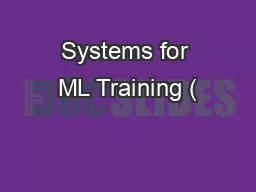PPT-Systems for ML Training (
Author : trish-goza | Published Date : 2018-09-23
TensorFlow On a single CPUGPU within a data center or across data centers Techniques used Data Parallelism Model Parallelism Parameter Server Goals Fast training
Presentation Embed Code
Download Presentation
Download Presentation The PPT/PDF document "Systems for ML Training (" is the property of its rightful owner. Permission is granted to download and print the materials on this website for personal, non-commercial use only, and to display it on your personal computer provided you do not modify the materials and that you retain all copyright notices contained in the materials. By downloading content from our website, you accept the terms of this agreement.
Systems for ML Training (: Transcript
Download Rules Of Document
"Systems for ML Training ("The content belongs to its owner. You may download and print it for personal use, without modification, and keep all copyright notices. By downloading, you agree to these terms.
Related Documents














